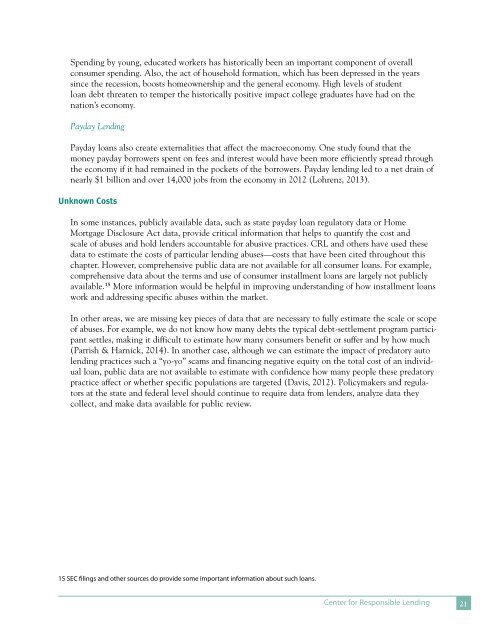Create successful ePaper yourself
Turn your PDF publications into a flip-book with our unique Google optimized e-Paper software.
Spending by young, educated workers has historically been an important component <strong>of</strong> overall<br />
consumer spending. Also, the act <strong>of</strong> household formation, which has been depressed in the years<br />
since the recession, boosts homeownership and the general economy. High levels <strong>of</strong> student<br />
loan debt threaten to temper the historically positive impact college graduates have had on the<br />
nation’s economy.<br />
Payday Lending<br />
Payday loans also create externalities that affect the macroeconomy. One study found that the<br />
money payday borrowers spent on fees and interest would have been more efficiently spread through<br />
the economy if it had remained in the pockets <strong>of</strong> the borrowers. Payday lending led to a net drain <strong>of</strong><br />
nearly $1 billion and over 14,000 jobs from the economy in 2012 (Lohrenz, 2013).<br />
Unknown <strong>Costs</strong><br />
In some instances, publicly available data, such as state payday loan regulatory data or Home<br />
Mortgage Disclosure Act data, provide critical information that helps to quantify the cost and<br />
scale <strong>of</strong> abuses and hold lenders accountable for abusive practices. CRL and others have used these<br />
data to estimate the costs <strong>of</strong> particular lending abuses—costs that have been cited throughout this<br />
chapter. However, comprehensive public data are not available for all consumer loans. For example,<br />
comprehensive data about the terms and use <strong>of</strong> consumer installment loans are largely not publicly<br />
available.15 More information would be helpful in improving understanding <strong>of</strong> how installment loans<br />
work and addressing specific abuses within the market.<br />
In other areas, we are missing key pieces <strong>of</strong> data that are necessary to fully estimate the scale or scope<br />
<strong>of</strong> abuses. For example, we do not know how many debts the typical debt-settlement program participant<br />
settles, making it difficult to estimate how many consumers benefit or suffer and by how much<br />
(Parrish & Harnick, 2014). In another case, although we can estimate the impact <strong>of</strong> predatory auto<br />
lending practices such a “yo-yo” scams and financing negative equity on the total cost <strong>of</strong> an individual<br />
loan, public data are not available to estimate with confidence how many people these predatory<br />
practice affect or whether specific populations are targeted (Davis, 2012). Policymakers and regulators<br />
at the state and federal level should continue to require data from lenders, analyze data they<br />
collect, and make data available for public review.<br />
15 SEC filings and other sources do provide some important information about such loans.<br />
Center for Responsible Lending 21


